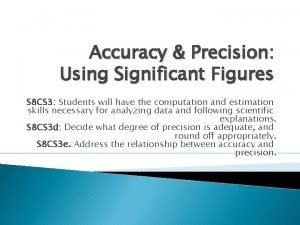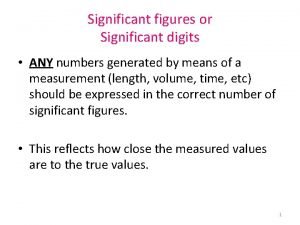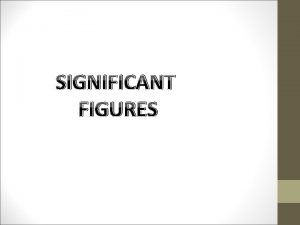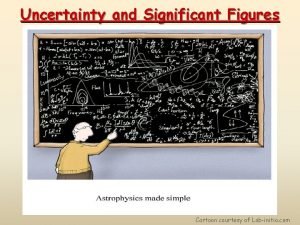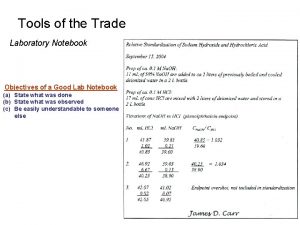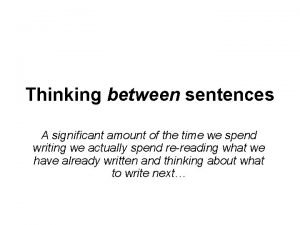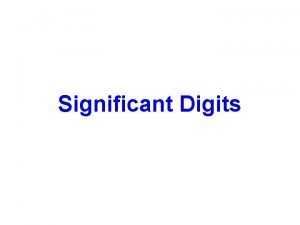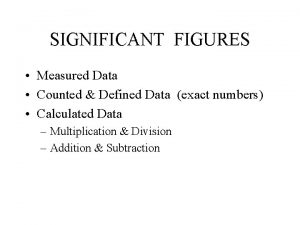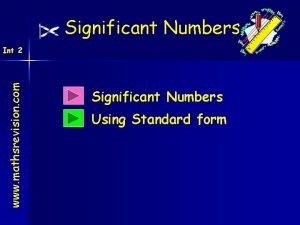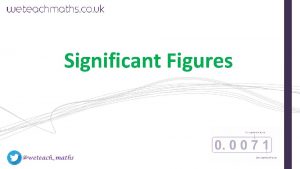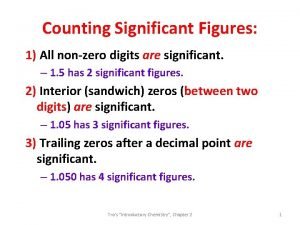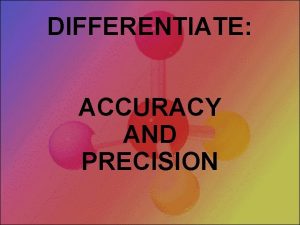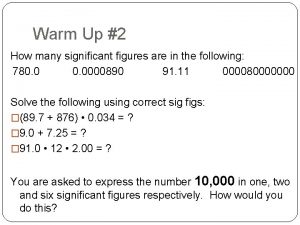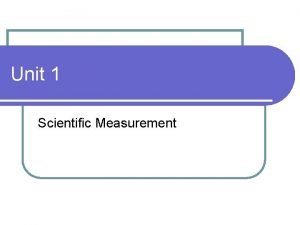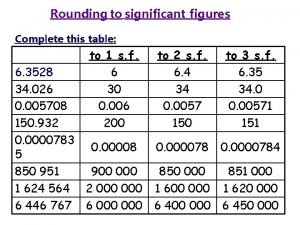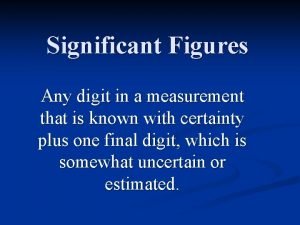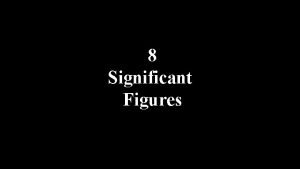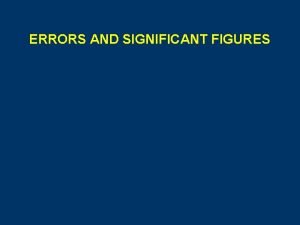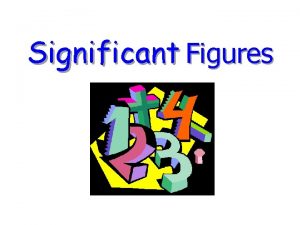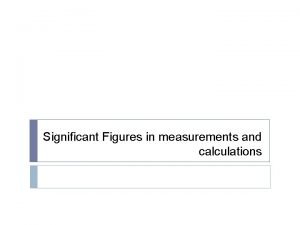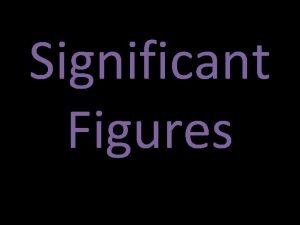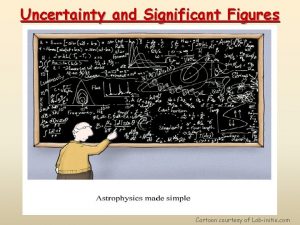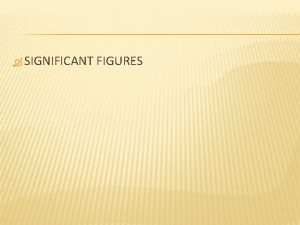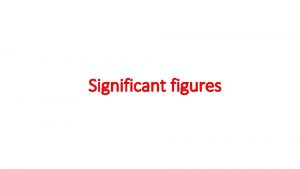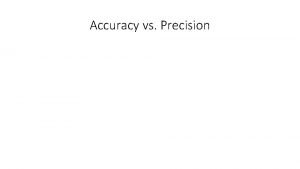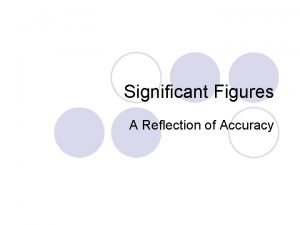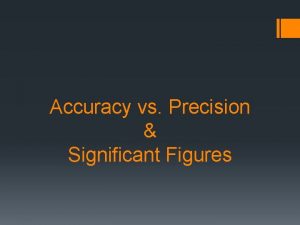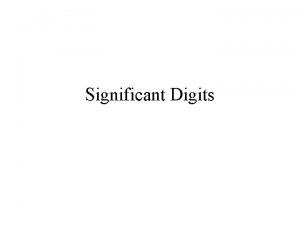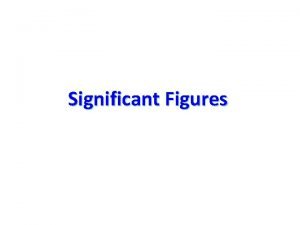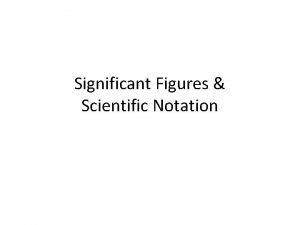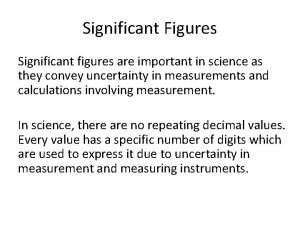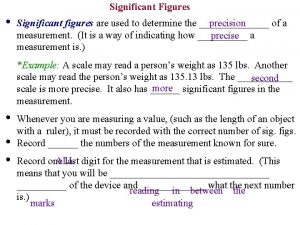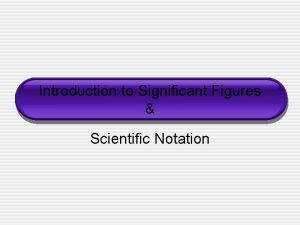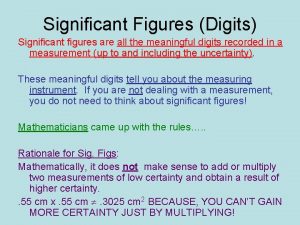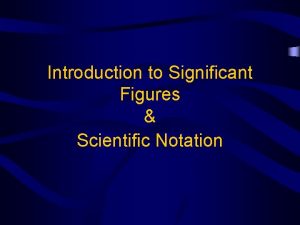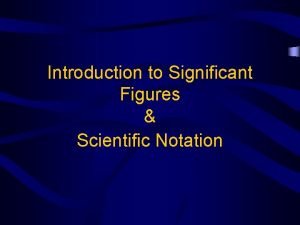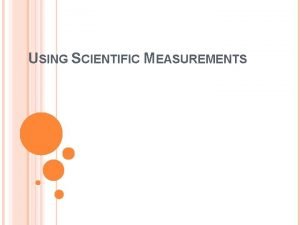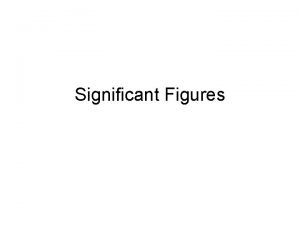Significant Figures What is accuracy How close the




























- Slides: 28

Significant Figures

What is accuracy? • How close the instrument measures to the accepted value • So if you are accurate, you are hitting your target • Think of sports, where if you are an accurate shooter, you are scoring or hitting where you need to hit.

Precision • The measurement is the same when taken multiple times. • General rule is the more precise an instrument is, the more digits it will have. • So if you are precise in measuring, you can take a lot of decimal places.

Example - 1 • Mr. Chio weighs 72. 351345 kg • If you measure and find the weight is 72. 35 kg? • If you measure multiple times and get 74. 323455? • If you measure multiple times and get 72. 350130 kg? • If you measure multiple times and get 89. 2?


Uncertainty • It is the uncertain nature of some measuring tools we have • This is because some instruments and tools we have in labs aren’t always accurate and instead can fluctuate and give us ranges • This is where error can come from • Every tool and instrument has an uncertainty, just the very accurate ones have VERY small uncertainty

Uncertainty • So when we measure things, we have uncertainty. It can range. • You measure an object to be 15. 2 cm. But the ruler may be off and you may have estimated that 0. 2 cm. It could have been 0. 15, 0. 16, 0. 17, 0. 18, 0. 19 …. 0. 24. So there is an uncertainty.

Uncertainty • When you measure 21. 45 cm ± 0. 05 cm, this means the thing you measured can be 21. 40 cm or 21. 50 cm. It is the range! • If the uncertainty is not given, but a range of values is given, such as 88. 0 and 89. 0. You can take the midpoint of the difference of the values and the midpoint of the values as your answer • (1/2)(89. 0 – 88. 0) = 0. 5 and (1/2)(88. 0 + 89. 0) • So it becomes 89. 5 ± 0. 5

Uncertainty • Please read Page 36 for more information • But your uncertainty of measurements of analog instruments is to take 1/10 of the smallest unnumbered subdivision. • So if on a ruler it is measure 1 mm, then the uncertainty is 1 mm x 1/10 = 0. 1 mm.

Significant Figures • Significant Figures are how accurate and precise we can make with a measurement without guessing. • Significant Figures are a rounding tool we have to make sure our answer is as precise and accurate as possible with the least number of uncertainty • We call it sig figs for short

Why we have significant figures? • • Because we trust the digits we are given too much A scale that measures your weight reads 75 kg. You trust it to be 75 kg, but can it be anything else? It can be anything from 74. 500000… all the way up to 75. 49999… – There an infinite possibility for your weight! • But since we can only see 75 kg, we can only trust it up to 75 kg. We cannot assume it is anything else! • This is why the 75 is significant. • Remember, the more digits it has, the more precise!

Rules of Significant Figures • All non-zero digits are significant • Zeroes between non-zero digits are significant • Zeroes to the left of non-zero digits are NOT significant • Zeroes to the right of non-zero digits if listed are significant ONLY if a decimal is shown!

All non-zero digits are significant • 2675 – 4 sig figs • 1333313 – 7 sig figs • 2 – 1 sig fig

Zeroes between non-zero digits are significant • • 2002 – 4 sig figs 506 – 3 sig figs 3000002 – 11 sig figs The last digit makes all the zeroes significant because the last digit is precise and not estimated

Zeroes to the left of non-zero digits are not significant • 0. 0003 – 1 sig fig • 0. 000045 – 2 sig figs • 00000056 – 2 sig figs

All zeroes to the right of non-zero digits are significant ONLY if a decimal is shown 29. 000 – 5 sig figs 29000 – 2 sig figs 5. 000 – 4 sig figs 32340000 – 4 sig figs (since the last 4 zeroes could be rounded off) • 230. – 3 sig figs as decimal is shown • • •

Example - 2 • • How many sig figs in each? 2. 0009 200000 2000. 2 0. 000290

Scientific notation and Sig Figs • • • Follows the same rules EXCEPT Exponential does not count as Significant 2. 95 x 103 is only 3 sig figs. The 103 is not significant. If we write it in standard, it becomes 2950 hence why only 3 sig figs as the 0 at the end is not significant.

Rounding • • Rounding rules are the same as elementary 0, 1, 2, 3, and 4, you round down 6, 7, 8 and 9 you round up… Wait, where is 5? What pattern do you notice is off? There are 5 numbers to round down! Only 4 to round up! This means it unfair for rounding up and makes most of your answers lower than the actual!

Rounding • We always did it where 3. 65 rounds up to 3. 7, but this is wrong! • This because we have a 4/9 chance of rounding down and a 5/9 chance of rounding up if we kept 5 as rounding up! • This skews our result if you are doing multiple calculations!

Rule of 5 • If the number ends in 5 and we were to round it to the digit to its left • 3. 65, we round it to the 6 digit place • We want to make the number we are rounding EVEN! • So it rounds to 3. 6, not 3. 7!

Example - 3 • 3. 65 • 3. 775 • 29. 45

More sig fig rules! • Yes, there are rules to multiplying and dividing values, we must round to the correct sig figs too! • There are rules for multiplying/dividing • And adding/subtracting

Multiplying and Dividing for Sig Figs • When you multiply or divide, you ROUND TO THE LEAST NUMBER OF SIG FIGS in the original question. • 3. 534 (4 sf) x 131 (3 sf) so our answer will be 463 (3 sf). The decimals in the end are not significant. • Same goes for division as division is just reciprocal multiplication.

Adding and Subtracting Sig Figs • You ROUND to the LEAST NUMBER of DECIMALS of your original question • 3. 23 + 1. 2 will = 4. 4 and not 4. 43. You only have 1 decimal place • 19. 45231321 – 1. 423 = 18. 029 (3 decimal place)

Multiple Operations for Sig Figs • You must count the sig figs of each step and perform sig fig reduction at every step • But round at the very end • Your final answer should follow the rules of every step! • BEDMAS

Example - 4 • 9. 34 x 0. 07146 – 6. 88 x 0. 08115

Practice - 1 • Page 37 - #55 • Page 39 - #56 (ace…) • Page 40 - #57 -59 (ace…)
 Accuracy and precision significant figures
Accuracy and precision significant figures How many significant figures are in the number 750.?
How many significant figures are in the number 750.? Significant figures in measurements
Significant figures in measurements Significant figures summary
Significant figures summary Types of error in measurement
Types of error in measurement Nernst equation
Nernst equation Logarithm significant figures
Logarithm significant figures Significant figures sentences
Significant figures sentences Three significant digits
Three significant digits Upper and lower bounds to 3 significant figures
Upper and lower bounds to 3 significant figures How many sig figs are in 7080
How many sig figs are in 7080 Rules of significant figures
Rules of significant figures Significant figures
Significant figures What are significant figures in maths
What are significant figures in maths Significant figures of whole numbers
Significant figures of whole numbers 2021 significant figures
2021 significant figures Significant figures chemistry
Significant figures chemistry How many significant figures are there in 4 702 000 cm?
How many significant figures are there in 4 702 000 cm? How many significant figures in 956
How many significant figures in 956 Measurement homework
Measurement homework Round 213 to 1 significant figure
Round 213 to 1 significant figure How many significant figures are in 3,000,001
How many significant figures are in 3,000,001 654 to 1 significant figure
654 to 1 significant figure Errors and significant figures
Errors and significant figures 987 to 2 significant figures
987 to 2 significant figures Sog fig rules
Sog fig rules 150 sig figs
150 sig figs How do significant figures work
How do significant figures work Significant figures cartoon
Significant figures cartoon
